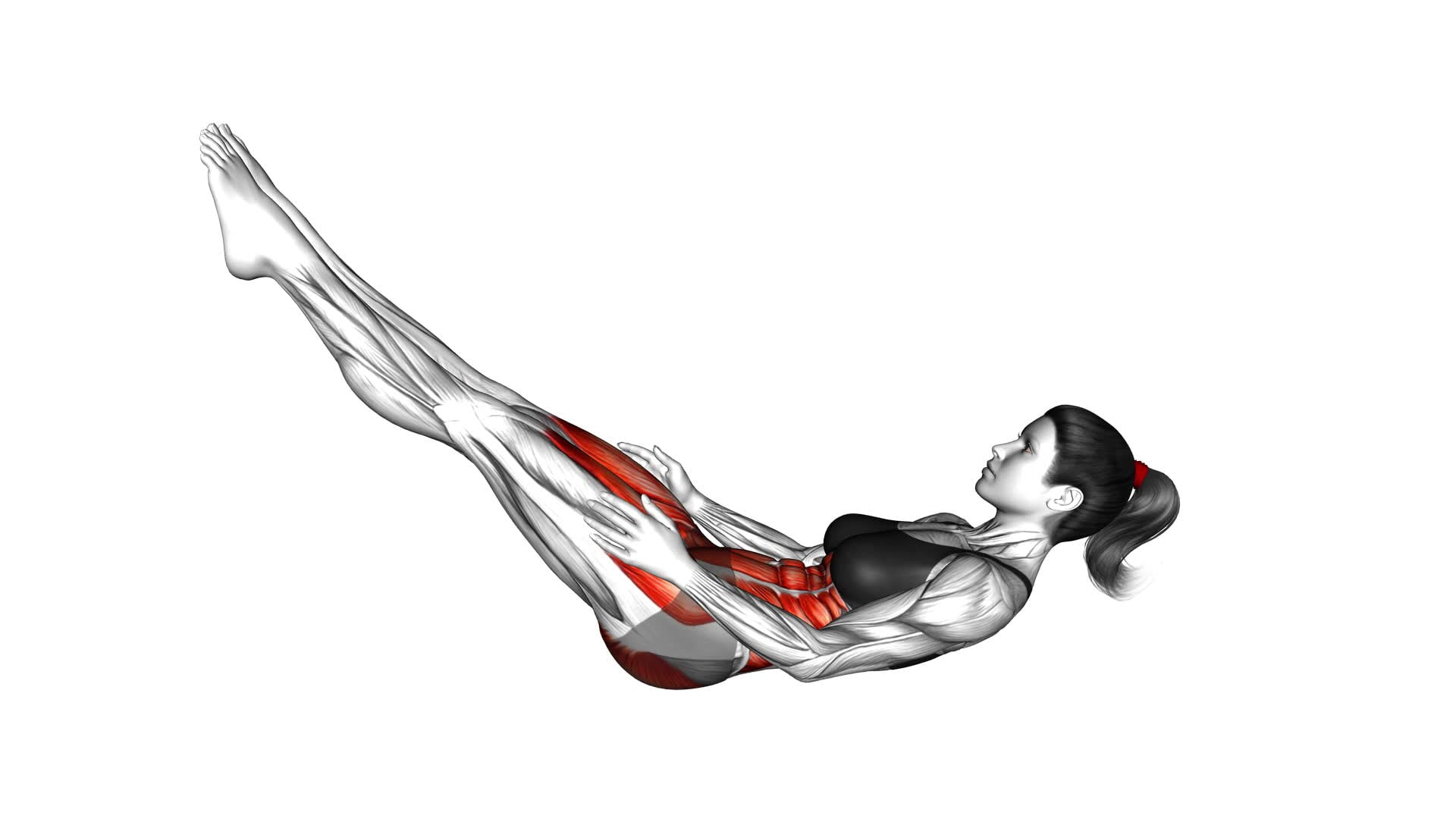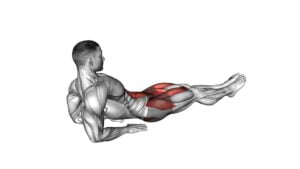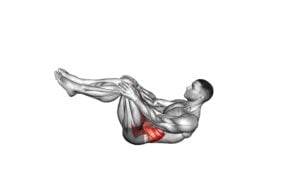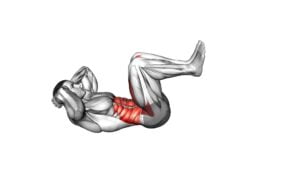Lying Alternating Knee Tuck (female) – Video Exercise Guide & Tips

Are you looking for a challenging exercise to strengthen your core and improve your overall fitness? Look no further than the lying alternating knee tuck.
Watch This Exercise Video
This exercise targets your abs, obliques, and hip flexors while also engaging your glutes and lower back.
In this video exercise guide, we'll show you the proper form and technique, offer modifications for different fitness levels, and provide tips to incorporate this exercise into your workout routine.
Get ready to feel the burn and see results with the lying alternating knee tuck.
Key Takeaways
- The lying alternating knee tuck targets lower abdominal muscles, improves posture and stability, enhances balance and coordination, and offers variations to increase or decrease intensity.
- Proper form and technique include lying flat on your back, bringing one knee towards the chest while lifting the head and shoulders off the ground, and alternating between legs with each repetition.
- Modifications and progressions for all fitness levels include variations like single leg knee tuck, Swiss ball knee tuck, hanging knee tuck, weighted knee tuck, and plyometric knee tuck.
- Techniques to increase the intensity of the exercise include increasing repetitions, decreasing rest time, adding resistance with ankle weights or resistance bands, elevating feet on a bench or step, and slowing down the movement for eccentric contraction and tension.
Benefits of the Lying Alternating Knee Tuck
The lying alternating knee tuck offers numerous benefits for women aiming to strengthen their core muscles. This exercise specifically targets the lower abdominal muscles, helping to tone and tighten the area. By engaging the core, it also helps improve posture and stability, reducing the risk of back pain and injury. Additionally, this exercise can help improve balance and coordination, as you're required to control your movements while lifting and lowering your legs.
One of the great things about the lying alternating knee tuck is that there are variations that can be done to increase or decrease the intensity of the exercise. For beginners, starting with bent legs and gradually straightening them as you become stronger is a good way to build up your core strength. You can also add resistance by using ankle weights or a resistance band around your thighs.
Proper Form and Technique for the Exercise
To perform the lying alternating knee tuck with proper form and technique, follow these steps.
First, lie flat on your back with your legs extended and your arms by your sides. Ensure your body is in proper alignment by engaging your core and keeping your spine neutral.
Next, bring your right knee towards your chest while simultaneously lifting your head and shoulders off the ground. As you do this, exhale and engage your abdominal muscles. Hold this position for a moment before slowly lowering your right leg back to the starting position as you inhale.
Repeat the same movement with your left leg, alternating between legs with each repetition.
It's important to maintain proper alignment throughout the exercise, keeping your lower back pressed into the floor and avoiding any excessive arching or rounding of the spine.
Remember to breathe consistently and smoothly throughout the movement, exhaling as you lift your knee and inhaling as you lower it.
Modifications and Progressions for All Fitness Levels
For all fitness levels, you can modify and progress the lying alternating knee tuck by incorporating different variations and increasing the intensity. Here are some ways to do so:
- Variation 1: Single Leg Knee Tuck: Instead of alternating legs, perform the exercise with one leg at a time. This will increase the stability challenge and engage your core muscles even more.
- Variation 2: Swiss Ball Knee Tuck: Place your feet on a Swiss ball instead of the floor. This adds an element of instability, requiring your core and stabilizer muscles to work harder.
- Variation 3: Hanging Knee Tuck: If you have access to a pull-up bar, hang from it and bring your knees up towards your chest. This variation targets your upper body and core simultaneously.
- Variation 4: Weighted Knee Tuck: Hold a dumbbell or medicine ball against your chest while performing the exercise. The added weight increases the resistance and challenges your muscles further.
- Variation 5: Plyometric Knee Tuck: Instead of bringing your knees towards your chest, explode upwards and tuck your knees as high as possible. This dynamic movement adds a cardiovascular component to the exercise and increases power and explosiveness.
To increase the intensity of the lying alternating knee tuck, you can try the following techniques:
- Technique 1: Increase Repetitions: Add more repetitions to your sets, gradually increasing the workload on your muscles.
- Technique 2: Decrease Rest Time: Shorten the rest periods between sets, keeping your muscles engaged and maintaining a higher intensity throughout the workout.
- Technique 3: Add Resistance: Use ankle weights or resistance bands to add resistance to the exercise, challenging your muscles even more.
- Technique 4: Elevate Your Feet: Place your feet on an elevated surface such as a bench or step, increasing the range of motion and difficulty.
- Technique 5: Slow Down the Movement: Focus on slowing down the lowering phase of the exercise, emphasizing the eccentric contraction of your muscles and creating more tension.
Common Mistakes to Avoid During the Lying Alternating Knee Tuck
Avoidance of common mistakes is crucial for effective execution of the Lying Alternating Knee Tuck. To ensure you get the most out of this exercise and minimize the risk of injury, it's important to maintain proper form.
One common mistake to avoid is using momentum to lift your legs instead of engaging your core muscles. This can diminish the effectiveness of the exercise and put unnecessary strain on your lower back. Instead, focus on using your abdominal muscles to lift and lower your legs in a controlled manner.
Another mistake to watch out for is allowing your lower back to arch excessively during the movement. This can lead to discomfort and potential injury. To maintain proper form, engage your core, imagine pressing your lower back into the floor, and keep your abdominal muscles activated throughout the exercise.
Lastly, be mindful of the position of your neck and shoulders. Avoid straining your neck by keeping it relaxed and aligned with your spine. Additionally, avoid shrugging your shoulders up towards your ears, as this can create tension in your neck and upper body.
Tips for Incorporating the Exercise Into Your Workout Routine
To effectively incorporate the Lying Alternating Knee Tuck into your workout routine, focus on maintaining proper form and engaging your core muscles throughout the exercise. Here are some tips to help you get the most out of this exercise:
- Start slow: Begin with a few reps and gradually increase the number as you become more comfortable with the movement.
- Control your movements: Avoid swinging your legs or using momentum to lift them. Instead, engage your abdominal muscles to lift your legs and perform the exercise in a controlled manner.
- Breathe properly: Remember to exhale as you lift your legs and inhale as you lower them back down. This will help you maintain stability and control throughout the exercise.
- Modify as needed: If the exercise feels too challenging, you can modify it by bending your knees slightly or performing the movement with one leg at a time.
- Add variations: Once you have mastered the basic Lying Alternating Knee Tuck, you can incorporate variations such as adding ankle weights or performing the exercise on an unstable surface to further challenge your core muscles.
Frequently Asked Questions
How Many Calories Does the Lying Alternating Knee Tuck Burn?
The lying alternating knee tuck is a great exercise for burning calories and toning your core muscles. To perform the exercise with proper form, follow these steps:
- Lie on your back.
- Lift your legs off the ground.
- Bring one knee towards your chest while extending the other leg straight.
- Alternate between legs in a controlled and slow motion.
Variations of this exercise include:
- Adding a twist.
- Holding a weight between your feet for added resistance.
These variations can help you challenge your muscles and make the exercise more intense. Remember to always listen to your body and adjust the exercise according to your fitness level.
Can the Lying Alternating Knee Tuck Be Done by Beginners?
Yes, the lying alternating knee tuck can be done by beginners. It's a beginner-friendly exercise that targets the abs and hip flexors.
To make it easier, you can modify the exercise by keeping your legs bent instead of straightening them. This will reduce the intensity and allow you to build strength gradually.
Some common mistakes in the lying alternating knee tuck include lifting the head and shoulders too high and using momentum instead of engaging the core muscles.
Can the Lying Alternating Knee Tuck Help Improve Core Strength?
The lying alternating knee tuck is a great exercise for improving core strength. It targets your abs and helps to tone and strengthen your midsection. By bringing your knees towards your chest and alternating between sides, you engage multiple muscles in your core.
There are variations of this exercise, such as adding a twist or holding a weight, to increase the intensity. For optimal results, it's recommended to perform the lying alternating knee tuck 2-3 times a week.
What Muscles Does the Lying Alternating Knee Tuck Target?
The lying alternating knee tuck is a powerful exercise that targets multiple muscles in your body. By engaging your core, it helps to improve core strength and stability.
Additionally, this exercise also targets your hip flexors and lower abdominal muscles.
To make the most of the lying alternating knee tuck, you can try different variations, such as adding a stability ball or using ankle weights. These variations provide additional challenges and further enhance the benefits of this exercise.
Is It Necessary to Use a Mat or a Specific Surface While Performing the Lying Alternating Knee Tuck?
Using a mat or specific surface for the lying alternating knee tuck can provide more comfort and stability. It isn't necessary to use a mat or specific surface while performing this exercise, but it can be beneficial.
The mat or surface can cushion your back and provide a more stable base for your movements. Additionally, it can help prevent slipping or sliding during the exercise.
Conclusion
Incorporating the lying alternating knee tuck into your workout routine can bring numerous benefits. This exercise targets the core muscles, improves stability, and enhances overall strength. By following proper form and technique, you can maximize the effectiveness of this exercise.
Remember to avoid common mistakes and make modifications as needed to accommodate your fitness level. With regular practice, the lying alternating knee tuck can help you achieve your fitness goals and improve your overall physical performance.

Author
Years ago, the spark of my life’s passion ignited in my mind the moment I stepped into the local gym for the first time. The inaugural bead of perspiration, the initial endeavor, the very first surge of endorphins, and a sense of pride that washed over me post-workout marked the beginning of my deep-seated interest in strength sports, fitness, and sports nutrition. This very curiosity blossomed rapidly into a profound fascination, propelling me to earn a Master’s degree in Physical Education from the Academy of Physical Education in Krakow, followed by a Sports Manager diploma from the Jagiellonian University. My journey of growth led me to gain more specialized qualifications, such as being a certified personal trainer with a focus on sports dietetics, a lifeguard, and an instructor for wellness and corrective gymnastics. Theoretical knowledge paired seamlessly with practical experience, reinforcing my belief that the transformation of individuals under my guidance was also a reflection of my personal growth. This belief holds true even today. Each day, I strive to push the boundaries and explore new realms. These realms gently elevate me to greater heights. The unique combination of passion for my field and the continuous quest for growth fuels my drive to break new ground.







